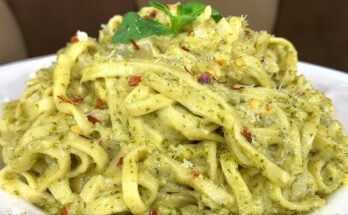Chinese Cabbage Recipe: Chinese cabbage, often known as Napa cabbage, is a staple in many Asian cuisines. It’s a leafy green vegetable with a mild, slightly sweet flavor that makes it incredibly versatile in cooking. Unlike regular cabbage, Chinese cabbage has a softer texture, making it ideal for stir-fries, soups, and even salads. It’s typically oblong in shape with pale green leaves that become whiter toward the base. Popular in Chinese, Korean, and Japanese dishes, it absorbs flavors well and cooks quickly.
You’ll often see Chinese cabbage in recipes like kimchi, dumplings, hot pots, or even as a low-carb wrap. It’s prized for its tender leaves and subtle taste. In short, it’s the kind of vegetable that’s both delicious and practical—exactly what you need in a go-to dish.
Health Benefits of Chinese Cabbage
Don’t let its humble appearance fool you—Chinese cabbage is a nutritional powerhouse. It’s loaded with fiber, which is great for digestion, and is low in calories, making it perfect for anyone looking to eat healthier. It’s also packed with essential vitamins like A, C, and K, plus minerals such as calcium and potassium.
One of the standout benefits of Chinese cabbage is its anti-inflammatory properties, thanks to its rich supply of antioxidants. It’s also great for your heart and immune system. Whether you’re watching your weight, aiming for clearer skin, or just want to boost your immune health, adding Chinese cabbage to your diet is a smart move.
Essential Ingredients for Chinese Cabbage Recipe
Main Ingredients
Here’s a basic rundown of what you’ll need to whip up a flavorful Chinese cabbage dish:
- 1 medium Chinese cabbage (Napa cabbage) – the star of the show
- 2 tablespoons vegetable oil – for stir-frying
- 3 cloves garlic, minced – for that aromatic base
- 1 thumb-sized piece of ginger, minced – adds a zingy warmth
- 2 tablespoons soy sauce – for umami and saltiness
- 1 tablespoon oyster sauce (optional) – adds depth
- 1 teaspoon sesame oil – nutty finish
- Salt and pepper to taste
These ingredients are simple, pantry-friendly, and make up a classic stir-fry base that you can customize endlessly. The flavor combo hits all the right notes: savory, slightly sweet, with a touch of earthy warmth.
Optional Add-Ons for Extra Flavor
Want to kick things up a notch? Try tossing in some of these extras:
- Chili flakes or fresh red chilies – for spice lovers
- Tofu, shrimp, or sliced chicken – for added protein
- Sliced mushrooms or carrots – to boost nutrition
- A dash of rice vinegar or lime juice – for acidity
You can get creative here. Chinese cabbage plays well with a variety of flavors, so feel free to experiment with what’s in your fridge or pantry. It’s one of those dishes that can adapt to whatever mood you’re in—light and refreshing or hearty and comforting.
Kitchen Tools You’ll Need
Basic Cooking Equipment
You don’t need a fancy kitchen setup to make this recipe shine. Here’s what you’ll need:
- Large skillet or wok – for quick, even cooking
- Cutting board and sharp knife – essential for prepping the cabbage
- Wooden spoon or spatula – for stirring everything up
- Measuring spoons – to get your seasoning just right
- Mixing bowl – optional, if prepping sauce ahead of time
Using a wok is ideal because of its high heat capacity, but a large nonstick skillet works just fine. The key is to have enough room to toss and stir your cabbage without overcrowding the pan.
Helpful Kitchen Tips Before You Start
Before diving into the actual cooking, here are a few tips that can make your life easier:
- Prep all your ingredients before turning on the heat. Chinese cabbage cooks quickly, so you don’t want to be chopping ginger while your garlic is burning.
- Cut the cabbage uniformly. This ensures even cooking and keeps the texture consistent throughout the dish.
- Use high heat. Stir-frying is all about quick cooking at high temps to lock in flavors and keep the veggies crisp.
- Don’t over-salt early. Soy sauce already adds a lot of saltiness, so taste before adding more.
Step-by-Step Chinese Cabbage Recipe
Step 1: Washing and Preparing the Cabbage
Start by removing any wilted or damaged outer leaves from the cabbage. Cut the cabbage lengthwise into quarters, then chop into bite-sized pieces, including both the leafy and white stalk parts. Rinse thoroughly under cold water to remove any dirt, then drain well or pat dry with a clean towel. Excess moisture can make your stir-fry soggy, so drying it well is important.
Chopping everything beforehand makes your cooking process smooth and fast. Trust me, once the heat is on, things move quickly. It’s best to have everything at arm’s reach.
Step 2: Sautéing the Aromatics
Now it’s time to build that irresistible base flavor. Heat two tablespoons of vegetable oil in your wok or skillet over medium-high heat. Once the oil is shimmering, add your minced garlic and ginger. Stir them quickly—don’t walk away! This part only takes 20-30 seconds. You’ll smell that beautiful fragrance as the aromatics release their oils.
The key here is not to burn the garlic, or it’ll turn bitter and overpower the dish. Stir constantly, allowing the garlic and ginger to turn a light golden color. This quick sauté acts as a flavor bomb, setting the tone for everything that comes next. Some people like to add a bit of sliced scallion at this stage for an extra punch, and you can totally do that too.
Want more depth? Add a teaspoon of chili flakes or a small dried chili pepper into the oil with the garlic and ginger for a spicy twist.
Step 3: Cooking the Cabbage to Perfection
Once the aromatics are sizzling, it’s time to add your chopped Chinese cabbage. Toss it right into the pan and crank up the heat to high. Stir-fry everything together, making sure the oil coats all the cabbage pieces. The heat will quickly start to soften the leaves while the stalks retain a satisfying crunch.
This part is a balancing act—cook too long and the cabbage becomes mushy, too short and it’s undercooked. Ideally, you want to stir-fry for about 5 to 7 minutes. The leafy parts should wilt slightly, and the stems should become translucent but still crisp.
Add your soy sauce and oyster sauce (if using) during the last few minutes of cooking. These sauces blend into the cabbage, giving it a savory, slightly sweet depth. Stir everything thoroughly so each bite is flavorful. Finally, add a splash of sesame oil at the end for a nutty aroma that ties the dish together.
Pro tip: If your cabbage releases too much water, let it simmer a minute longer uncovered to evaporate the excess liquid.
Step 4: Adding Final Seasonings
With the cabbage now tender and infused with the umami-rich sauces, it’s time to add those finishing touches. Taste the dish before adding salt—remember, soy sauce already brings in a salty profile. If it needs more, go ahead and add a pinch of salt and a crack of black pepper. Some people like a pinch of sugar to balance the savory tones; feel free to add half a teaspoon if you prefer a touch of sweetness.
This is also the stage where you can introduce add-ons like cooked tofu, shredded chicken, or even a beaten egg stirred in for a richer dish. Make sure everything is heated through and well mixed.
Lastly, top it off with chopped green onions or a sprinkle of sesame seeds for added texture and flavor. Once that’s done, turn off the heat and get ready to serve!
Serving Suggestions
What to Serve With Chinese Cabbage
Chinese cabbage stir-fry is incredibly versatile—it can stand on its own or play a supporting role in a bigger meal. Here are a few serving ideas to make your meal complete:
- Steamed Rice – The classic choice. A simple bowl of jasmine or basmati rice pairs beautifully with the savory cabbage.
- Fried Rice or Noodles – Serve the cabbage on top of fried rice or lo mein noodles for a hearty, restaurant-style dish.
- Protein Pairings – This dish goes well with grilled chicken, pork chops, or pan-seared tofu.
- Wraps or Rolls – Spoon it into lettuce leaves or rice paper for a low-carb appetizer or light lunch.
If you’re going for a full dinner spread, consider pairing the cabbage with dumplings, hot and sour soup, or a simple egg drop soup. The textures and flavors balance each other out perfectly.
Storage and Reheating Tips
Leftovers? No problem! Chinese cabbage stir-fry stores very well, making it ideal for meal prep.
- Storage: Let the dish cool completely before transferring it to an airtight container. Store it in the fridge for up to 3 days.
- Freezing: While it’s technically possible to freeze this dish, the texture of the cabbage may suffer a bit upon thawing. It’s best enjoyed fresh or within a few days.
- Reheating: Reheat in a skillet over medium heat for 3-4 minutes or microwave it in 30-second bursts until hot. Add a splash of water or broth if it looks too dry.
Pro tip: If you plan to reheat, slightly undercook the cabbage during the initial cooking phase. This helps it retain more texture after warming up again.
FAQs about Chinese Cabbage Recipe
1. Can I freeze cooked Chinese cabbage?
Technically, yes. But it’s not always ideal. When you freeze and reheat cooked Chinese cabbage, its texture can become mushy due to its high water content. If you must freeze it, do so in an airtight container and use it within one month. When reheating, use a skillet and cook on low heat to retain as much texture as possible.
2. What protein goes best with this recipe?
This dish pairs well with all kinds of proteins. Chicken, shrimp, pork, beef, and tofu are all excellent choices. For quick options, try tossing in some pre-cooked rotisserie chicken or sautéed shrimp right at the end. If you’re vegetarian or vegan, firm tofu or tempeh is a great way to add substance.
3. How do I make it spicy?
If you like heat, you’ve got options! Add a teaspoon of red pepper flakes, a chopped fresh chili, or a spoonful of chili garlic sauce during the sauté stage. You can also drizzle some Sriracha or chili oil on top just before serving. Adjust to your spice tolerance and enjoy the kick!
4. Can I use Napa cabbage instead?
Absolutely. In fact, Napa cabbage is often used interchangeably with Chinese cabbage in many recipes. It has a similar mild flavor and tender texture. Just be aware that Napa cabbage cooks a little faster, so keep an eye on it to avoid overcooking.
5. Is this recipe keto-friendly?
Yes! Chinese cabbage is naturally low in carbs, making this stir-fry perfect for keto diets—especially if you skip the oyster sauce and go easy on the soy sauce. Pair it with grilled meat or eggs for a full keto meal. For extra fat, drizzle with sesame oil or top with a fried egg.
Conclusion
And there you have it—a super simple yet incredibly flavorful Chinese cabbage recipe you can whip up in under 20 minutes. Whether you’re new to cooking or a seasoned home chef, this dish fits right into your weekly rotation. It’s quick, healthy, budget-friendly, and bursting with flavor. With just a handful of ingredients, you’ve transformed a humble vegetable into a savory, satisfying meal that pairs perfectly with almost anything.
One of the best things about this recipe is how flexible it is. You can keep it light for a healthy lunch or load it up with protein for a hearty dinner. It’s also a great way to clean out your fridge—those half-used veggies or leftover meats? Toss them in! You can even experiment with different sauces to create your own signature version.
So the next time you’re wondering what to cook, grab a head of Chinese cabbage and give this recipe a try. You might just find yourself making it again and again. Happy cooking!



